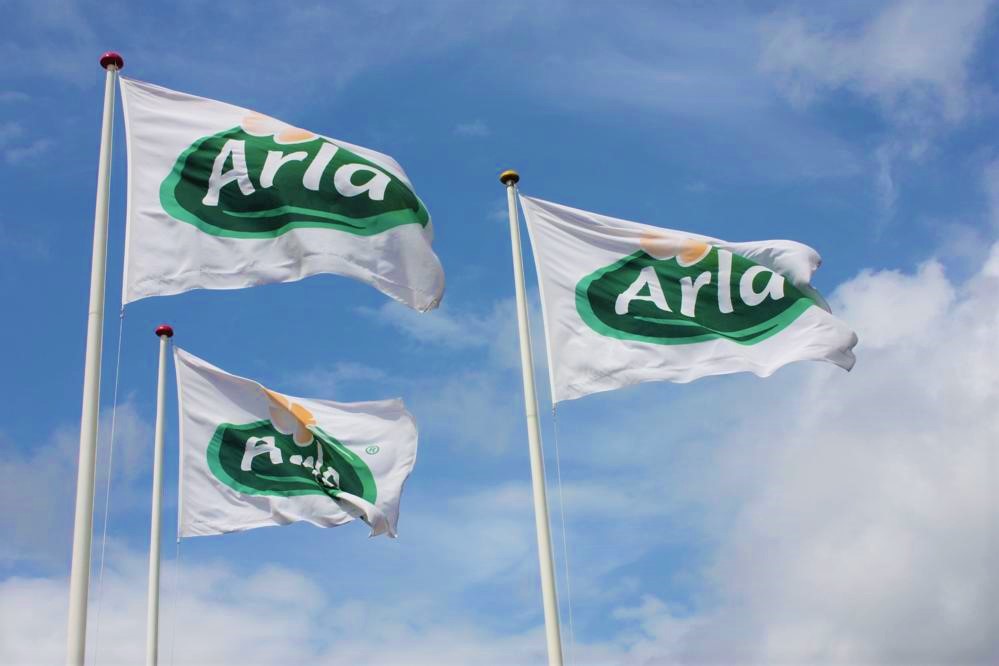Arla Foods has launched ambitious targets to eventually eliminate net carbon emissions from its business.
The focus will be on reducing the environmental impact across Arla’s 10,300 suppliers’ farms.
The main target is to reduce greenhouse gas emissions by 30%/kg of milk over the next decade and to work towards carbon net zero by 2050.
Dairy farmer and Arla Foods chairman Jan Toft Norgaard said: “We want to leverage our position as the leading international farming cooperative with 10,300 farmers and perhaps the most comprehensive understanding of dairy farming and production in Northern Europe to accelerate the transition to sustainable dairy production.
We have worked towards sustainable farming for years and we need to go further and faster, not least to help fight climate change, which affects everyone on the planet, especially us farmers.
The new strategy covers the whole value chain from cow to consumer and addresses the areas climate, air, water and nature.
“With our farmers’ further commitment, we are in a strong position to ensure that people maintain confidence in dairy as part of a healthy and sustainable diet for the future,” added chief executive Peder Tuborgh.
“Dairy is enjoyed across the world and plays an important role in providing nourishment to a growing world population – from a basic glass of fresh school milk to advanced whey proteins used in optimised medical nutrition.”
The target of 2050 is set for all Arla markets, however, it’s expected some countries will reach the targets sooner based on local conditions.
Tuborgh explained that the business will also explore commercial opportunities in the market to help drive the change.
“We believe that a growing number of consumers are willing to reward the most sustainable dairy farmers by paying a little more for their milk in the same way as we have seen with organic dairy.”
Tools and knowledge to drive reductions on-farm
While it is not possible to completely eliminate a cow’s methane emissions, the co-op says that this can be significantly reduced; for example, through optimised feed composition.
To counteract the emissions, an important part of the strategy is working with farmers to quantify and increase the carbon captured and stored in the soil to increase their positive contribution.
For the farmer, a key enabler is to understand where the farm’s main climate impact is and how it can be reduced. Since 2013, Arla has held almost 700 on-farm meetings to educate groups of farmers on sustainability measures. Over this period more than 5,000 climate assessments have also been carried out on Arla suppliers’ farms.
“The climate assessment is highly motivating, because it identifies your farms’ potential for CO2 reductions, which will often lead to cost savings,” explained Jan Toft Norgaard, who has used the tool on his own farm.
During 2018, Arla established a digital documentation database called Arlagarden Plus to help Arla and the individual farmer to systematically measure and benchmark the farm performance.
So far, 96% of Arla’s milk pool is accounted for on the system making it one of the largest dairy farm benchmarking datasets in Europe. Farmers record information about their herd, milking system, feed, grazing, land use and animal welfare on a quarterly basis.
“A next step is to include parameters that will indicate the farm’s impact on climate and environment. This will give us an opportunity to see in which areas we have the biggest potential, to identify best practice farms that we can learn from across our cooperative,” said Jan Toft Norgaard.
Since 1990, Arla farmers have reduced emissions per kilo of milk by 24%. The CO2 reduction from Arla’s operations, including packaging and transport, has been 22% since 2005 – even though Arla’s milk intake since then has grown by over 40%.
The company has also committed to making its operations more sustainable – for example, by moving away from fossil fuels, using sustainable packaging and generating less waste.
According to a recent analysis from the UN’s Food and Agricultural Organisation (FAO), global milk production continues to become more efficient and sustainable with a global average of 2.5 kg CO2/kg of milk.
Arla farmers contribute to this result with average emissions of 1.15 kg CO2/kg of milk – about half of the global average.

